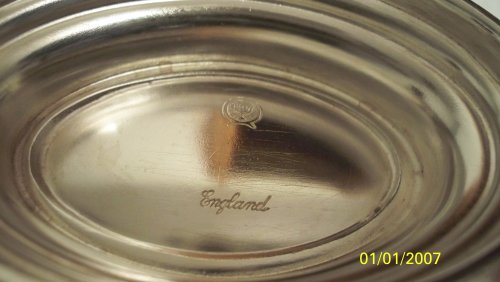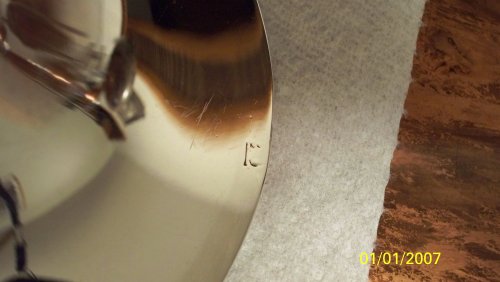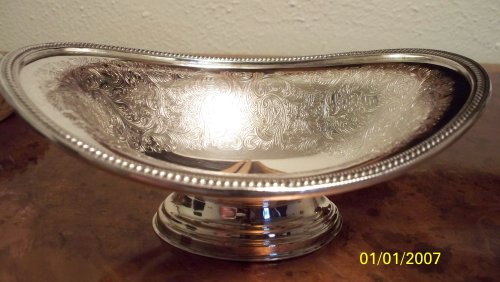I have recently (the photo dates are incorrect, as I just changed the battery) acquired two oval fruit/vegetable bowls from my mother, who is divesting her collections. She stated that it was solid silver at the time she gave it to me, but I had my doubts since there is no marking other than the Menorah and England (Barker or Barker-Ellis, or Ellis-Barker depending upon your side of the pond). Anyhow, I took them to a jeweler and he tested them to be solid silver. My question is this: WHY AREN’T THEY MARKED and is there a ton of solid silver Barker-Ellis being sold as silver plate when in fact it may be solid silver? I had him test both the bowl and it’s foot to make sure, and both tested positive (acid test). Actually, it’s pretty obvious that it is solid silver in that there are a few fairly deep knicks, and they are silver at the base of the knick/dent/worn areas. Also, both bowls have a weird mark at the edge (see photo) that looks like some type of imprint, but I can’t identify it.



Regarding the acid test, I authorized the jeweler to use a file and test the filed areas as long as I was allowed to watch, and the filing was performed on inconspicuous edges. Secondly, we also tested a non-solid silver item, to insure the freshness of the acid, which did indeed react with the non-sterling test piece. I know that the rule is that if it isn’t Hallmarked or marked sterling, it isn’t sterling, but I am now questioning that due to the test results on my two pieces.
Thanks for your very interesting query. Clearly these bowls have avoided the marking process for some reason and we can only speculate why. Have you asked your mother how she acquired them?
My first idea is that they were perhaps a private gift from the makers - silver only has to be hallmarked if it is “exposed for sale” (and on that point may I remind you that it would be illegal for you to attempt to sell these as silver in the UK).
My second idea is that they were exported and managed to miss the “sterling” stamping process at the Ellis-Barker side of the operation. If that is the case then there may well be a whole batch of items out there which were exported at the same time.
And for my third idea - which is probably way off base - they may have been stolen from the factory or the importers before the marking could be done.
Thank you for your response. My mother acquired the pieces as a gift after many years of service as personal assistant to a woman who comes from a prominent local family. Unfortunately, this woman is now in the early to midpoint stages of Altzheimer’s and is unable to recall from whence the pieces came. Her mother, in turn, may have given them to her, but that is not verifiable. Both her father and her mother were well travelled and fairly well connected, In addition, the lady that gave them to my mother was at one time married to a U.S. senator and was prone to travel and receiving personal gifts from many sources, including the U.K. Unfortunately, that is the extent of the provenance on these two pieces. Do you have any advice as to the best way to document the pieces as not being merely silverplate in light of a lack of hallmarks? Will a jeweler’s statement be sufficient, or would I need to employ an assayer? I reside in the U.S., so U.K. laws would not apply. However, at this time I am not interested in parting company with the pieces, especially in light of their unique status.
My feeling is that the jewellers statement, if properly signed on headed paper, should be enough for most purposes. If you want these pieces to be fully covered by your insurance you should probably seek guidance from your insurance company. When the time comes to sell them it may be neccessary to get some more formal evidence but until then I suggest you sit back and enjoy them.
Hi Im new to this site & have just started collecting silver peices I Googled barker ellis & Found this site with your bowls … Am interested in knowing the sizes of them . I have required one very similar but may be smaller . Its 13.5cm wide & 17 cm long , no markings exept for the barker ellis name & made in england underneath it . Its avery solid & nice bowl. Any more info regarding it would be good
Back in the 1970s I worked in a shop which sold Barker Ellis silverware, including pieces such as yours. They were described as sweet dishes and were without exception, silver plated. I am 99% sure that your piece is silver plated on a copper base. The surface of the dish in the first picture looks to be consistent with silver plate.
I think that you need a second opinion other than that of your jeweller. Barker Ellis did plate to a very high standard. If I remember correctly to a minimum of 50 microns. It is possible that the test was not good enough to give a conclusive result. Alternatively, take them back to the jeweller who tested them as silver and ask him to buy them off you as such
that is so interest I bought exacly this bowl today on a church market…and its my first silver piece. It is not in a mint condition, but I really like it. I picket it up for 3 australian dollar. Does anyone know what the circa value is.
thanks so much
Katrin
Following up on my earlier posts, I heeded the advice about the unique thickness of the silver plate and took the pieces back to be tested in a “deep scratch” scenario. The silver, although very thick by most plating standards, was indeed plate. From the information given to me by the a local assayer it appears these pieces probably had hand applied thick silver plate material instead of electroplate and thus the original test was not deep enough to get to the underlying copper. Anyhow, the results are that it is silver plate, albeit a very thick plate.
Barker and Ellis seem to have several marks on their silver plate --do we know what their significance is—pine apple—gate—ms----jewish candle stick